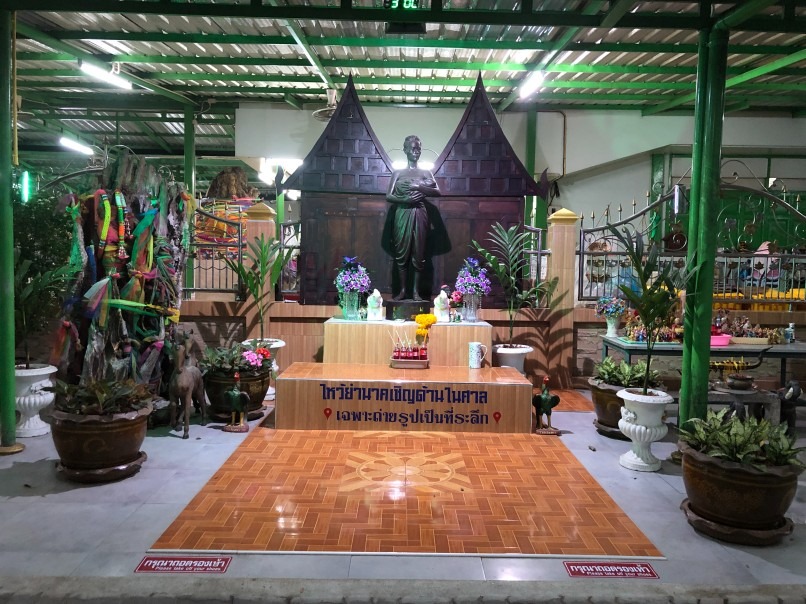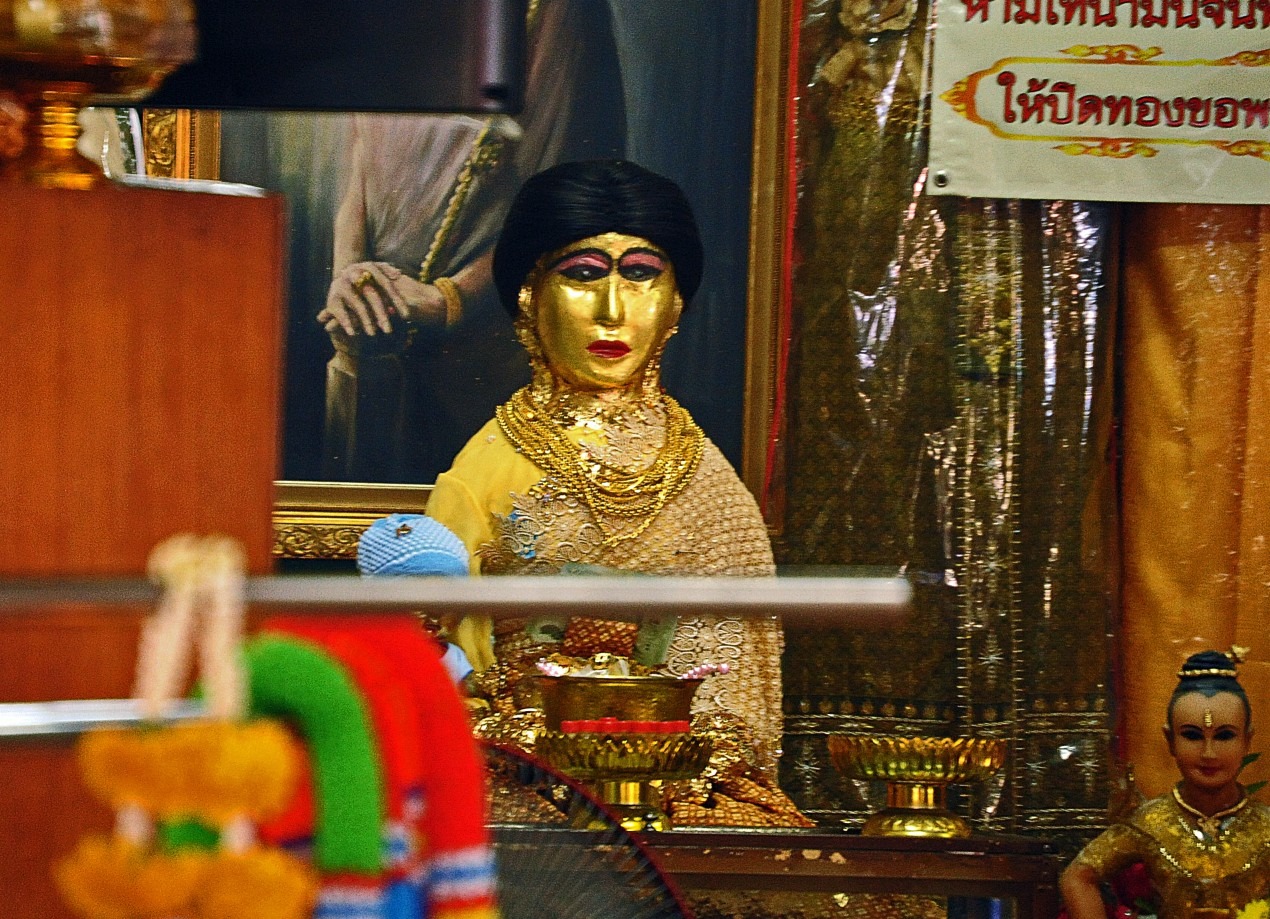The Curse of Mae Nak

By Shruti Kothari
Staff Writer
16/10/2019

In Thailand, the supernatural is as natural as the evergreen flora. Almost 95% of the population is Buddhist, in a way that’s woven closely with animism. Spirit houses stand at the very front of every house, condominium, office, or hotel; if you don’t stop to wai when you pass one, you probably aren’t local. While many of these spirit houses are there to appease the spirits of the land they’re built on, a few spirits have merited their own standalone shrines. By far the most famous spirit, or phi, is Mae Nak (Lady Nak), who is said to have strangled villagers to death, and whose shrine attracts hundreds of visitors daily. That’s right, the most popular spirit in the land of smiles, the friendliest country in the world, is a homicidal ghost.
What’s the story there? In the mid-19th century, during the reign of King Rama IV, Thailand was still known as Siam. Phra Khanong, now a neighborhood bustling with expats in concrete high-rises, consisted of marshy rice paddies and water buffaloes. Villages were made up of small clusters of stilt houses, and in one of these houses lived the young Maak, with his beautiful, pregnant wife, Nak. Deeply in love, the couple led a simple life together.
One day, though, the army came knocking; Maak was to join the military, to fight the Shan people of Burma. Duty-bound and left with no choice, he comforted Nak, telling her he would return soon.
He was not a warrior, and while he fought the best he could, he was wounded in battle, and made to stay in Thonburi some time while he convalesced. Meanwhile, the weeks passed relentlessly for Nak, who, with no news, was beginning to despair. Her belly grew rounder, and with Maak away, she went into labor.
The villagers helped however they could, but in the end, neither Nak nor her baby survived. Fearful, because the death of a pregnant woman was a terrible omen and her spirit twice as strong, the villagers neglected to observe the proper rituals. Rather than cremate her, they buried Nak and her baby in a shallow grave.
Fearful, because the death of a pregnant woman was a terrible omen and her spirit twice as strong, the villagers neglected to observe the proper rituals.
Nak’s spirit yearned to be reunited with her love. Time ticked on. Her stilt house fell into disrepair, clogged with dust and soft with rot, vines growing through the walls and slats in the floor.
Maak, finally well enough to travel, returned. He entered his home, which looked as he had left it, to find his wife and child waiting for him. Joyful, they lived as a family, falling quickly into a new routine around the baby.
A neighbor tried to warn Maak that his wife was not as she seemed, and his house had become uninhabitable. Before he could get the words out, he choked, and died. As Maak went about his days in the village, this became a pattern: his neighbors choking to death around him.
One night he came home while Nak was in the kitchen. Busy making nam phrik, she didn’t notice him. In her haste, a lime fell from her hand, to the ground and through the floorboards. Without thinking, she extended her arm; it stretched down, past her knees and then her ankles and then through the slats, to retrieve the fallen lime. She retracted it and continued cooking.
Maak was stunned. Everything that happened since his return fell into place. He could now see the dust and ruin around him. When he collected his wits, he told Nak he would go outside to relieve himself.
He found a clay pot, filled it with water and tied it to a tree right by their house. He punctured the bottom, so that a distinct trickling noise could be heard, to fool the ghost. Maak then made his escape.
Nak, realizing that her husband was spending far too long outside, went to look for him. She saw the punctured pot. She tried to find Maak, but couldn’t; he had hidden behind a nad bush, well-known for confusing ghosts. He managed to reach the temple Wat Mahabut, where monks formed a protective circle around him. They created a boundary with a length of string and powerful chants that Nak couldn’t cross.
In her rage, Nak began to terrorize and murder the villagers of Phra Khanong indiscriminately, until the monks managed to contain her spirit in a jar, which they threw in a river. Some believe that Maak went on to become a monk himself, to pray for the spirit of his dead wife. Others say he started a new family.
Nak began to terrorize and murder the villagers of Phra Khanong indiscriminately, until the monks managed to contain her spirit in a jar.
Many years later, a fisherman found the jar, and unaware of what lay inside, opened it and set Nak free, who went back to haunting the people of Phra Khanong. She was contained once again, this time by the famous monk Somdej. He exhumed her body and took a piece of bone from her forehead, and then convinced Nak to enter it with promises that it would ensure her reunion with Maak in their next reincarnations.
Once she was captured, he wore the bone as an amulet in his sash for the rest of his life. After his passing, it is said that the sash was inherited by the royal family, a rumor which was confirmed by Prince Abhakara Kiartivongse, a son of King Chulalongkorn, sometime in the early 1900s. They are said to be in possession of it to this day.
Mae Nak has become by far the most well-liked ghost in Thailand; as a child, Prince Damrong, a son of King Mongkut and father of the current Thai education system, claims to have asked many people who the most popular person in the country was. Most replied, Mae Nak.
Prince Damrong, claims to have asked many people who the most popular person in the country was. Most replied, Mae Nak.
Over the years, Mae Nak has appeared in print media, operas, and around 20 films; a 2013 horror-comedy rendition, Pee Mak, remains the highest grossing Thai film. It sold a staggering 16 million tickets across Asia and made it as far as the US. Perhaps its popularity here in Thailand is due to the fact that in this version, Mae Nak finally sees a happy ending: Nak and Maak, ghost and human, decide that they love each other and live together forevermore.
There’s a shrine dedicated to her right in the Wat Mahabut complex that she was once kept out of. But why do Thai people, in particular the people of Phra Khanong, the very neighborhood she once terrorized, pray to a ghost with a history of murder?
One temple-goer, who has been visiting every week for the last 20 years, said because Mae Nak’s shrine was at Wat Mahabut, she could be with Maak; no longer vengeful, she uses her powers to help people now. According to one of the temple monks, it’s because her malicious spirit is contained, and she is now a benevolent ghost — as long as you keep her appeased. Thailand, a deeply superstitious country, has countless ghosts, even benevolent ones: there’s Mae Sue, for example, who stands guard over infant children, and Pee Ka Takood, who brings fertility to fields.
But Mae Nak Pha Khanong remains the most widely revered. Perhaps it is because she’s seen as a woman with boundless love for her husband; her tragedy was caused by war, and timing, and her actions were all borne from a desire to be with Maak. In any case, she has undergone apotheosis, and her shrine, full of paintings and statues of her (often holding her baby), draws many visitors and vendors every day.

An altar to Mae Nak
It’s unclear whether pregnant women should visit: some are told to stay away from the shrine for obvious reasons, while others are encouraged to visit and ask for easy childbirth, as Mae Nak feels strongly about it. Young couples who cannot conceive also ask for her help. In particular, parking at or even near the temple complex becomes nigh impossible on the 1st and 16th of every month, as well as every April. The first two are when lottery draws are announced; Nak is said to bring good luck, and people sell lottery tickets there too. April sees families and wives or girlfriends praying fervently for the young men in their lives, as it’s the month of the military draft, which works on a lottery system in Thailand. Mae Nak hates conscription, and is said to protect all men from such a fate.
Inside the shrine, the bust of Mae Nak, decked out in full makeup, necklaces, and an ever-changing traditional Thai sabai, has been covered by devotees in gold leaf. Her hair is lifelike enough to comb. A television, set up so that it faces her, is kept on all the time to entertain her with Thai soap operas, Muay Thai matches, and movies. Offerings around her include sweets, red Fanta (most Thai shrines and spirit houses will have bottles of red Fanta in or around them as a handy replacement for blood sacrifice), along with baby bottles and toys for her child.

Bust of Mae Nak
There is a canal near the temple, and you can buy fish or eels to release into the khlong to make merit. This is believed not only to help the devotee, but also Mae Nak, as releasing the animals alleviates some of the bad karma she built up during her killing sprees.
The main thing to remember when praying at this temple is that if your wish comes true, you must return to thank Mae Nak. She may be benevolent, but if you don’t show your gratitude by either buying her new clothes (conveniently available at the shrine itself), or by hiring traditional Thai performers to dance in her honor, she is likely to take offense and reverse your good luck.
In a religion where there is no master plan, no one God who is responsible for the fate of men, the concept of karma provides explanation for a poor crop yield despite excellent weather, or an unwanted pregnancy. In Thailand, however, Buddhism is deeply interlaced with Hindu traditions. This tradition provides people with a host of ghosts and deities who can be propitiated for help, giving people a sense of control over the chaos of life.
